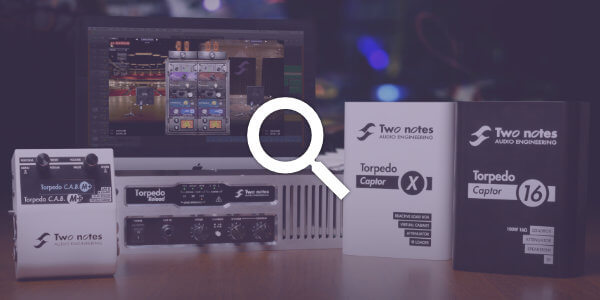The Torpedo Captor X is equipped with a red LED to signal the following events or issues with your Torpedo Captor X:
-
Clipping of the input or the output stages of the Torpedo Captor X
-
File transfer with the Remote software
-
System errors, unrelated to the incoming signal
- Clipping the input or output It is possible to overload the input or output stages of the Torpedo Captor X. The red LED will then light up, according to the signal. Start by turning the Output Level down. If the LED is still lighting up when you play, you are clipping the input of the Torpedo Captor X. Engage the IN LEVEL switch see front panel image, element N°7 to the LOW position. It activates a -15dB pad on the input signal. If the LOW switch is engaged and you are still clipping the input stage of the Captor X, turn down the volume of the amp until the red LED turns itself off. With Torpedo remote, you can see the input and output levels through the dedicated VUmeters.
- Communication with Remote When a file transfer is occurring between the Torpedo Captor X and the Remote software, the red LED acts as a progress indicator: it flashes when a certain percentage of the data is actually sent. This allows to check if the transfer is occurring normally, or has stalled. This happens when transferring virtual cabinets, IR files, and firmware files (during firmware updates).
- System error The Torpedo Captor X red LED flashes when an error is detected inside the firmware of the unit. To differentiate system error LED flashes from input or output clipping, turn off your amp, and disconnect it from the Torpedo Captor X. If the Captor X keeps flashing red light while being unplugged from the amp, this shows a system error. You can decipher the flashes as detailed below. If this happens, please submit a ticket on the helpdesk with the transcription of the LED report.
Some Torpedo products are equipped with a display, which is used to control the device, and to display a report when an error is detected in the firmware. Some other products don’t have a display, so they report errors another way: through a blinking LED.
An error report consists of two numbers, each one from 0 to 255. These numbers are displayed through the red LED on the device. Here is how one number is displayed on the LED:
-
Each digit X is indicated by the LED flashing X times (from 1 to 9). Zero (0) is indicated by a fast double flash.
-
Then, there is a pause between digits.
-
And after all digits have been flashed, there is a longer pause, then the whole thing starts again.
A few examples:
-
The number “5” is indicated by five flashes.
-
The number “30” is indicated by three flashes, a pause, and two fast flashes.
-
The number “128” is indicated by one flash, a pause, two flashes, a pause, eight flashes.
In all these cases, the indicated pattern is displayed, then there is a longer pause, and the pattern is flashed again, and so on.
When an error occurs, the first number of the error report is displayed. Pressing the push-button* on the unit once will display the second number of the report. Then, pressing it a second time will either erase the error indicator or reboot the unit, depending on the error. If for any reason pressing the push button doesn’t work, simply reboot the unit (turn it off and on again).
Several errors can be triggered simultaneously, in which case several pushes of the button or several reboot of the unit may be required.
*The push-button may be hidden, placed at the rear or bottom of the unit. If the push-button is accessible through a hole, use a pen or other small object to press it.
-
On the Torpedo Captor X, the push button is accessible through a small hole between the Out Level and Voicing potentiometers.
-
On the Revv D20 and G20, the push button is accessible through a small hole next to the USB connector.





 Terms and Conditions apply
Terms and Conditions apply
Using my Captor X between 40 watt amp and speaker, am seeing the red light come on while playing with volume control 9 o’clock. I would think this is far below rated power of Captor. Inputs/outputs on Torpedo SW are not clipping. Should I be concerned of a possible fault?
Hi Craig, Thank you for getting in touch. This isnt anything to worry about – have you tried pushing the sensitivity switch on the front panel of the unit to see if this removes the clipping indicator?